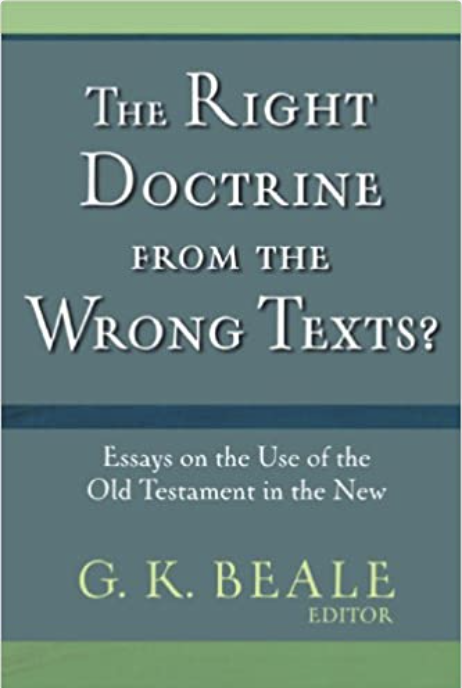Lesson 3: Learning Our Hermeneutic from the Bible
Following the Bible's Example?
The aim of this course is to build a biblical framework for interpretation. That is, to learn from Scripture how to interpret Scripture. But before we can do so, we need to ask: Is it appropriate for us to follow the example of biblical authors?
As you read the following passages, ask yourself the question, “Should we interpret the Bible the way the authors of these NT passages interpret the OT?”
Psalm 44 in Romans 8
Who shall separate us from the love of Christ? Shall tribulation, or distress, or persecution, or famine, or nakedness, or danger, or sword? As it is written, "For your sake we are being killed all the day long; we are regarded as sheep to be slaughtered." —Romans 8:35-36 (quoting Psalm 44:22)
Here Paul uses Psalm 44, a psalm lamenting Israel's exile, to describe the trouble faced by new covenant Christians. Should we follow Paul's hermeneutic by using this book similarly?
Deuteronomy 25 in 1 Corinthians 9
Do I say these things on human authority? Does not the Law say the same? For it is written in the Law of Moses, "You shall not muzzle an ox when it treads out the grain." Is it for oxen that God is concerned? Does he not certainly speak for our sake? It was written for our sake, because the plowman should plow in hope and the thresher thresh in hope of sharing in the crop. If we have sown spiritual things among you, is it too much if we reap material things from you? —1 Corinthians 9:8-11 (quoting Deuteronomy 25:4)
Here again Paul uses the OT to instruct Christians. But this time he uses an OT law. More than that, he uses an OT law about oxen to ground his assertion that church leaders have a right to financial support. How does Paul get from oxen to apostles? Should we follow his hermeneutic? Can we?
Sarah and Hagar in Galatians 4
For it is written that Abraham had two sons, one by a slave woman and one by a free woman. But the son of the slave was born according to the flesh, while the son of the free woman was born through promise. Now this may be interpreted allegorically: these women are two covenants. One is from Mount Sinai, bearing children for slavery; she is Hagar. —Galatians 4:22-24 (referencing Genesis)
This time Paul interprets an OT narrative allegorically, tying Hagar to the old covenant and Sarah to the new. Is it right for Paul to use an OT narrative like this? Should we follow his example?
Only Two Options
The passages quoted above are but a small sample of the wide variety of NT texts in which a biblical author quotes or alludes to an OT text. Many respected scholars have examined the NT use of the OT and have concluded that the interpretive methods NT authors employ were uniquely a result of the Holy Spirit’s inspiration. As such, they suggest that these texts do not represent a model which we can or should follow. “We are not inspired biblical authors. Thus, just because the biblical author does it, doesn't mean we can!”
The authors of this course, however, hold that the NT writers used a hermeneutic in reading and applying the OT Scriptures that does provide a sound model for us to follow. Our foundational argument in support of this position is that the Bible demands that we follow its own hermeneutic. Jesus condemns the Pharisees for not interpreting Moses in his light (John 5:46). Paul declares that the Law was always meant to lead us to Christ (Rom 10:4). The author of Hebrews reasons that we should interpret the rest Joshua provided Israel as a temporary sign of a greater rest provided in Christ (Heb 4:8–10). James expects Elijah’s example to fuel our praying (Jas 5:17). Peter urges us to understand that the OT prophets were writing for us about Christ (1 Pet 1:10–12). Learning to follow the Bible’s own hermeneutic requires time, humility, and rigorous study. But we can and must learn to read the Bible as the Bible itself demands to be read. That's what the rest of this course teaches us to do.
Besides, we must honestly ask the question: “If we are not willing to follow the Bible's example on interpretation, what is the alternative?” The only honest answer to the question is to derive our hermeneutic from our personal judgment, what someone taught us, or tradition—all helpful sources, but none authoritative. If Scripture is our infallible and authoritative guide, why should it not guide us by teaching us how to interpret it?
If we are not willing to follow the Bible's example on interpretation, what is the alternative?
To be sure, there are a host of complex issues, most of which are beyond the scope of this lesson. In the remaining steps, we intend to demonstrate, through the examples presented, that helpful principles can be learned from biblical authors as they use previously recorded Scriptures in their own texts.
 The Right Doctrine from the Wrong Texts, edited by G.K. Beale
The Right Doctrine from the Wrong Texts, edited by G.K. BealeThese essays cover many issues on how New Testament authors used Old Testament texts.
 Do Not Muzzle the Ox: Does Paul Quote Moses Out of Context? by Justin Taylor
Do Not Muzzle the Ox: Does Paul Quote Moses Out of Context? by Justin TaylorThis blog post by Justin Taylor presents a helpful discussion on the 1 Corinthians 9 passage quoted above. His work also serves as an instructive model for how to exegete NT passages that quote OT texts.